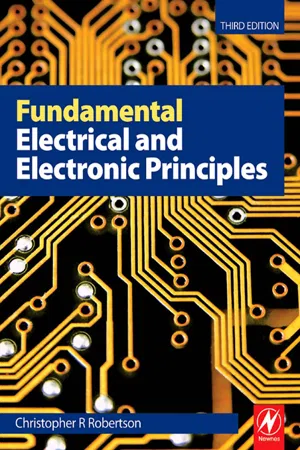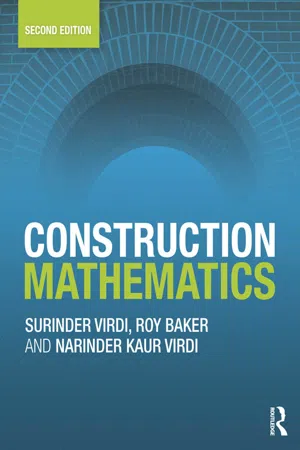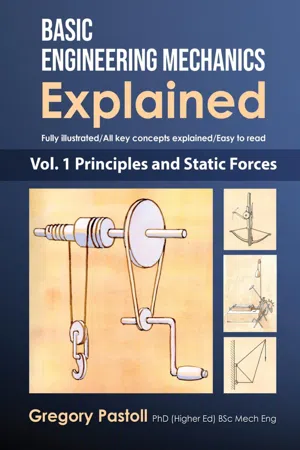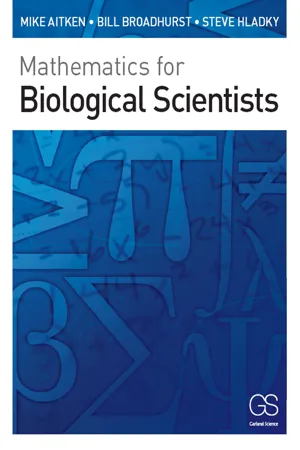Physics
Standard Form Physics
Standard form in physics refers to a way of writing very large or very small numbers using powers of 10. It is written in the form A × 10^n, where A is a number greater than or equal to 1 and less than 10, and n is an integer. This notation simplifies the representation of numbers and makes it easier to work with extremely large or small values.
Written by Perlego with AI-assistance
Related key terms
Related key terms
1 of 4
Related key terms
1 of 3
4 Key excerpts on "Standard Form Physics"
- No longer available |Learn more
- C R Robertson(Author)
- 2008(Publication Date)
- Routledge(Publisher)
Chapter 1 Fundamentals 1.1 UnitsWherever measurements are performed there is a need for a coherent and practical system of units. In science and engineering the International System of units (SI units) form the basis of all units used. There are seven ‘base’ units from which all the other units are derived, called derived units.Table 1.1 The SI base unitsQuantity Unit Unit symbol Mass kilogram kg Length metre m Time second s Electric current ampere A Temperature kelvin K Luminous intensity candela cd Amount of substance mole mol A few examples of derived units are shown in Table 1.2 , and it is worth noting that different symbols are used to represent the quantity and its associated unit in each case.Table 1.2 Some SI derived unitsFor a more comprehensive list of SI units see Appendix A at the back of the book.1.2 Standard Form Notation Standard form is a method of writing large and small numbers in a form that is more convenient than writing a large number of trailing or leading zeroes. For example the speed of light is approximately 300 000 000 m/s. When written in standard form this figure would appears as3.0 × 108 m/s, where 108 represents 100 000 000Similarly, if the wavelength of ‘red’ light is approximately 0.000 000 767 m, it is more convenient to write it in standard form as7.67 × 10−7 m, where 10−7 = 1/10 000 000It should be noted that whenever a ‘multiplying’ factor is required, the base 10 is raised to a positive power. When a ‘dividing’ factor is required, a negative power is used. This is illustrated below:One restriction that is applied when using standard form is that only the first non-zero digit must appear before the decimal point. Thus, 46 500 is written as4.65 × 104 and not as 46.5 × 103Similarly, 0.002 69 is written as2.69 × 10−3 and not as 26.9 × 10−4 or 269 × 10−51.3 ‘Scientific’ NotationThis notation has the advantage of using the base 10 raised to a power but it is not restricted to the placement of the decimal point. It has the added advantage that the base 10 raised to certain powers have unique symbols assigned. - eBook - ePub
- Surinder Virdi, Roy Baker, Narinder Kaur Virdi(Authors)
- 2014(Publication Date)
- Routledge(Publisher)
CHAPTER 5Standard form, significant figures and estimation
Learning outcomes: (a) Write a number in the standard form (b) Write a number to any number of significant figures (c) Estimate the answer of a calculation5.1 Standard form
In scientific calculations, it is more convenient to write large or small numbers in a form known as the standard form. In the standard form a number is split into two parts: (a) a decimal number that is greater than 1 but less than 10; and(b) 10n , where n could be a positive or negative integer, depending on the original number.For example, 3530 is written in the standard form as:3530 = 3.530 × 103As a starting point 3530 can be written as 3530.0 The first part (a) should be more than 1.0 but less than 10. Therefore move the decimal point by three places to the left to achieve this:The second part (b ) is a number that we must introduce to keep the value of 3530 unchanged. Since we have moved the decimal by three places to the left (or reduced the value of 3530), therefore, we must multiply 3.5300 by 1000. The three zeros in 1000 correspond to the number of places that the decimal has been moved.3.5300 × b = 3.5300 × 10001000 can further be written as 10 × 10 × 10 or 103 . Therefore,3.5300 × 1000 = 3.5300 × 103 = 3.53 × 103 (3.5300 = 3.53)Another method of representing 3530 (which is not much different from the above) in the standard form is to divide and multiply it by 1000. This will not change the value of 3530 and at the same time will result in 1000 a number that is greater than 1 but less than 10.A similar approach can be used if a number is less than 1. Consider 0.05, which can be written in a fractional form as: Example 5.1 Write the following numbers in the standard form: (a) 425; (b) 15 230; (c) 0.0056; (d) 0.0000621Solution:(a) 425 can also be written as 425.0: (b) 15 230 can be written as 15230.0:(c)In this question the decimal point has been moved to the right by three places. Division by 1000 is necessary to keep the number unchanged. The three zeros in 1000 correspond to the number of places that the decimal has been moved. - eBook - ePub
Basic Engineering Mechanics Explained, Volume 1
Principles and Static Forces
- Gregory Pastoll, Gregory Pastoll(Authors)
- 2019(Publication Date)
- Gregory Pastoll(Publisher)
Chapter 3 Working with numbers in engineering• Engineering notation, as opposed to scientific or ordinary notation• The number of significant figures in a value• Required format of answers for engineering purposes• Loss of accuracy when rounding off numbers during a calculation• The units that apply to mechanical quantities in the S.I. system• The difference between precision and accuracy• The limitations of precision in a primarily practical science• Converting the units of quantities, e.g. miles per hour to metres per second• Units preferred by engineersAn engineering student needs to know how to write and interpret numbers for the purposes of engineering. At some stage in your career, you will be writing lab and other types of investigative reports, performing calculations, and showing the results of your calculations. It is essential to get to know the conventions.Engineering notation, as opposed to scientific or ordinary notation Any given number can be expressed in three ways: ordinary arithmetic notation, scientific notation, and engineering notation.Ordinary arithmetic notation is what comes up on your calculator readout when you key in a sequence of digits. For example: 86.5 or 374.29 or 128502.972Scientific notation is a way of writing a number in terms of multiples of powers of ten. For example: 1.284 × 104 or 4.932 × 1017 or 7.996 × 10−6 . In scientific notation, the aim is to express the number as compactly as possible. Only one digit is allowed in front of the decimal point, and any multiple of powers of 10 can be used.Often, however, numbers expressed in scientific notation, though mathematically valid, are not conveniently practical for engineers to work with. For this reason, engineering notation was developed.Consider the number, in ordinary notation: 154 300. A scientist would write it as 1.543 x 105, whereas an engineer would write it as 154.3 x 103. If both are mathematically correct, what’s the difference, and why is there a difference? - eBook - ePub
- Mike Aitken, Bill Broadhurst, Stephen Hladky(Authors)
- 2009(Publication Date)
- Garland Science(Publisher)
to say, whichever way we choose to do it, we would not normally write out all the steps. To multiply or divide numbers in scientific notation we multiply or divide the coefficients and add or subtract the exponents, for example 3.45 × 10 3 × 2.71 × 10 − 1 = (3.45 × 10 × 10 × 10) × (2.71 ÷ 10) = 3.45 × 2.71 × 10 × 10 × 10 ÷ 10 = 9.35 × 10 × 10 = 9.35 × 10 2 or, more. concisely 3.45 × 10 3 × 2.71 × 10 − 1 = 3.45 × 2.71 × 10 (3 − 1) = 9.35 × 10 2. The 9.35 is just the product of the coefficients; the 2 in the exponent of 10 2 counts up the number of times we need to multiply by 10. There is a very similar procedure for division, for example 3.45 × 10 − 3 ÷ 2.3 × 10 1 = (3.45 / 2.3) × 10 − 3 − 1 = 1.5 × 10 − 4. If, after multiplying or dividing the coefficients and rounding the answer to the desired number of significant figures (three, say), the portion of the number to the left of the decimal point is not in the range from 1 to 10 (excluding 10 itself), then we. multiply or divide by 10 so that it is, and adjust the exponent accordingly. For example: initial answer intermediate step final form 13.3 × 10 3 (13.3 / 10) × (10 × 10 3) 1.33 × 10 4 0.678 × 10 − 5 (0.678 × 10) × (10 − 5 / 10) 6.78 × 10 − 6. 2.7 Solving equations Scientists frequently need to solve equations. In this section we shall see some methods that can be used, but first we need to define some of the language and look at the basic manipulations of expressions and equations that we need to be able to do. Some basics An equation is a statement that two expressions are equal to each other; for example, 2 + 3 = 5 or 2 x – 3 az = 2 y. An expression is a combination of symbols; for example, 2 + 3 or 2 x – 3 az. A part of an expression is called a sub-expression of that expression; for example, 2 is a sub-expression of 2 + 3 = 5 and 3 a is a sub-expression of 2 x – 3 az
Index pages curate the most relevant extracts from our library of academic textbooks. They’ve been created using an in-house natural language model (NLM), each adding context and meaning to key research topics.
Explore more topic indexes
Explore more topic indexes
1 of 6
Explore more topic indexes
1 of 4



